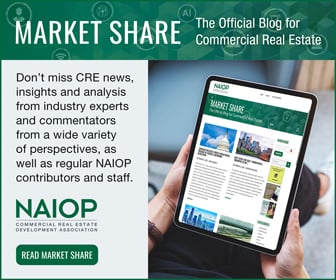Tradepoint Atlantic: A Modern Industrial Revival

A former steel mill site is being redeveloped into a major East Coast logistical hub.
Tradepoint Atlantic in Baltimore has transformed a former steel mill into one of the largest global logistics hubs in the country. The 3,300-acre site offers access to deep water berths, rail and highways. It is projected to generate more than 10,000 permanent jobs and $2.9 billion in annual economic impact by the time it is fully built out, which is expected to take about 15 years.
A History Forged in Steel
Sparrows Point, once home to the largest iron- and steel-making facility in the world, closed in June 2012 after 125 years in operation. In 2014, Tradepoint Atlantic purchased the site for $110 million and began developing it.
“Sparrows Point was iconic in the Baltimore region, a symbol of strength and ingenuity, supplying steel for two world wars and employing generations of families,” said Aaron Tomarchio, Tradepoint Atlantic’s executive vice president for corporate affairs. “But when it closed, it left many asking, ‘What does the next chapter look like? How do we reuse a site like this, and how are we going to clean up the environmental legacy left behind?’”
Working With the Community
For more than a century, the steel plant at Sparrows Point played a vital role in the lives of its employees and the overall community. That has continued with Tradepoint Atlantic. Since the project began, the development team has prioritized hiring from within the community, working with the community, and keeping communications with the community open and transparent.
“We continually outreach to local stakeholders and hold regular open house events to build relationships and trust,” said Tomarchio. “We work directly with the community, from business owners who want to understand the redevelopment plans for the site and the potential impact to their operations, to real estate agents who want to understand the opportunities in the surrounding market; from environmental groups who want to understand the environmental cleanup that is underway, to neighbors who want to understand the changing landscape around their community.”
A key aspect to the growth of Tradepoint Atlantic has been support from both local and statewide elected leadership. This has enabled the site to transform from an aging steel plant into a modern logistical hub.
From Maryland’s congressional delegation, to Governor Larry Hogan, to multiple Baltimore County executives, as well as key leaders in the state General Assembly, the team at Tradepoint Atlantic has communicated the development process, timeline, and why the overall mission of the site is pivotal to the economic growth of the local community and to Maryland as a whole.
“Tradepoint Atlantic and the world-class companies they continue to bring to Maryland is nothing short of an incredible success story,” said Hogan. “Our administration has made increasing business at the Port of Baltimore a top priority, and it is clear those efforts are paying dividends.”
Over the past six years, Tradepoint Atlantic has been able to secure several federal, state and local grants, which have helped invest in core infrastructure to move the project forward at critical times. For example, in October 2020, the development received a $9.8 million grant from the Department of Transportation’s new Port Infrastructure Development Program that will help build crucial infrastructure for shipping activity. This includes rail loops, conveyor systems and storage domes.
A Focus on Sustainability
A dedicated team monitors and manages an ongoing $68 million environmental clean-up process while in-house planning, engineering and design teams are actively working on building out 15 million square feet of vertical development.
In 2019, the team finished removing sediment and capping the Tin Mill Canal, which had collected wastewater, process water and stormwater for decades before the steel mill closed. Sediment containing unhealthy levels of oil and grease was excavated and removed, and the canal was covered with an engineered barrier that will support acceptable stormwater conveyance while improving and protecting water quality.
“Tin Mill Canal is living proof of the tremendous progress in the overall cleanup of Sparrows Point after more than a century of steelmaking,” said Ben Grumbles, secretary of the Maryland Department of the Environment. “The cleanup being done by Tradepoint Atlantic under Maryland Department of the Environment and U.S. Environmental Protection Agency oversight shows the value of working in partnership to benefit Maryland’s economy while ensuring the environment and public health are protected.”
Built to Accommodate
Tradepoint Atlantic was built and designed to accommodate many types of industries, from e-commerce giant Amazon to urban farming company Gotham Greens. It offers the largest multimodal site available in the land-constrained Washington/Baltimore market with the ability to deliver build-to-suit or raw land for development.
With over 8 million square feet of newly constructed facilities, the site features more than 1,000 readily developable acres and an additional 7 million square feet of future development opportunities for logistics, distribution, manufacturing and retail.
Tradepoint Atlantic has benefitted from an efficient and proven fast-track process. The Maryland Department of the Environment, the Environmental Protection Agency and Baltimore County government have worked to ensure that approvals and permitting have gone smoothly.
Creating Jobs for the Future
From the start of Tradepoint Atlantic, it was understood that the success of the project would largely depend on attracting major companies to locate, invest and grow their logistics operations at the site. The list of 30 companies that now call Tradepoint Atlantic home includes FedEx, Home Depot, Under Armour, Purdue, Volkswagen, BG&E and BMW, among many others.
With these partners and more in the pipeline, it is anticipated that Tradepoint Atlantic will meet and exceed the goal of 10,000 jobs on site in 2021.
Tradepoint Atlantic is a member of the Port of Baltimore, the economic engine for Maryland’s regional economy and one of the fastest-growing ports in North America. Benefits of this location include available land, flexible industrial zoning and proximity to the third-largest consumer group in the country. Additionally, the Baltimore region is home to a diverse labor force of more than 740,000 skilled professional and technical workers.
By Road, Sea or Rail
Tradepoint Atlantic was designed to increase efficiency for its clients through a combination of access to marine, rail and land channels. One of the unique assets found at Tradepoint Atlantic is the 1,200-foot-by-199-foot dry dock.
After a year of work and planning, Tradepoint Atlantic welcomed BAE Systems’ “Titan” floating dry dock for ship maintenance and repair in June 2020. With the arrival of the Titan, Sparrows Point is once again playing a role supporting America’s defense readiness.
And the largest privately owned short-line railroad on the East Coast serves the site with 70 miles of track. It connects to two Class I railroads, CSX and Norfolk Southern, which helps tenants and shippers reach markets across the U.S.
Looking Ahead
While the COVID-19 pandemic has changed so much about the ways people live, work and do business, it’s clear that its effect on the supply chain and e-commerce will continue to be felt for years to come. Tradepoint Atlantic is positioned to adapt to the ever-changing and often unpredictable world of global logistics and commerce.
Incentives to Partner
Tradepoint Atlantic offers competitive federal, state and local economic incentives to qualifying companies and is actively engaged with the Maryland Department of Commerce and Baltimore County to identify additional incentives. These include the following:
Baltimore Foreign Trade Zone. Located in or near U.S. Customs and Border Protection (CBP) ports of entry, Foreign Trade Zones (FTZ) are the U.S. version of what are known internationally as free-trade zones. They allow delayed or reduced duty payments on foreign merchandise. Active FTZ users can store, assemble, repackage or manufacture foreign and domestic merchandise.
Baltimore Gas and Electric (BGE) Smart Energy for Economic Development (SEED) Program. The SEED Program allows qualifying businesses to reduce BGE charges for service extensions and temporarily decreases energy distribution charges. BGE’s SEED Program offers eligible commercial customers a 25% reduction on electric and natural gas distribution and demand charges and a 75% discount on service extension costs (for businesses located in a Maryland Enterprise Zone).
Baltimore County Enterprise Zones. Enterprise Zone incentives include the following: The Real Property Tax Credit allows eligible companies that make improvements to real property in the Enterprise Zone to benefit from property tax credits over a 10-year period. The State Income Tax Credit allows eligible companies located in the Enterprise Zone to benefit from a state income tax credit for newly hired employees. The BGE “Rider 7” Electricity Price Reduction Program offers price rate reductions on new or incremental electricity load increases of 200kW or more per month for companies that increase employment by at least 10 full-time equivalent persons.
More Jobs For Marylanders Act – Tier 1 Location. This legislation promotes the growth of manufacturing in Maryland by providing tax incentives for manufacturing job creation, encouraging manufacturers to invest in new equipment through accelerated and bonus depreciation, and funding job training and apprenticeship programs to help strengthen Maryland’s workforce. In 2019, the tax credit program was expanded to non-manufacturers that locate or expand in Opportunity Zones and create new manufacturing jobs and to non-manufacturers that locate or expand in Maryland Opportunity Zones. The benefits are available for a 10-year period
Sales and Use Tax Exemption on Construction Materials/Equipment. Qualifying businesses can take advantage of 6% state sales and use tax exemption on construction materials, warehousing and manufacturing equipment.
Kerry Doyle and Marc Salotti are managing directors for Tradepoint Atlantic.








